Brian Connolly
Amazon SEO, Email Marketing, Product Listing Optimization, Selling on Amazon, Uncategorized
The days of ignoring Amazon SEO, throwing up any old product on Amazon, and then waiting for the paychecks to start rolling in are long gone. Instead, in an increasingly competitive marketplace, Amazon continues to develop algorithms to match sellers’ products with their shoppers. Your product has to be relevant.
Today, if you’re not maximizing the impact of your Amazon SEO, you’re in great danger of falling in search rankings and losing out on sales.
So, if you’re ready to boost your SEO strategy and claim your rightful share of sales and exposure, we’ll go over the following ins and outs of Amazon SEO and how to start optimizing your listing so you can improve your rankings today.
Search engine optimization, or SEO, is the process of increasing the quality and quantity of website traffic by increasing visibility of a website or a web page to users of an online search engine.
While this might seem like an odd concept considering Amazon is an e-commerce website (and SEO is often considered a Google-related need), it’s actually highly relevant.
Shoppers tend to browse both sites when shopping online: 56% of U.S. consumers start their product searches on Amazon, according to Jungle Scout’s Consumer Trends Report.
While Google and Amazon’s search algorithms are similar in some ways, Amazon’s A9 algorithm has shopping in mind—it returns the most relevant products as search results, as opposed to the informational articles Google surfaces. In this way, Amazon streamlines a shopper’s journey from search to purchase – which is why most consumers start their search on Amazon.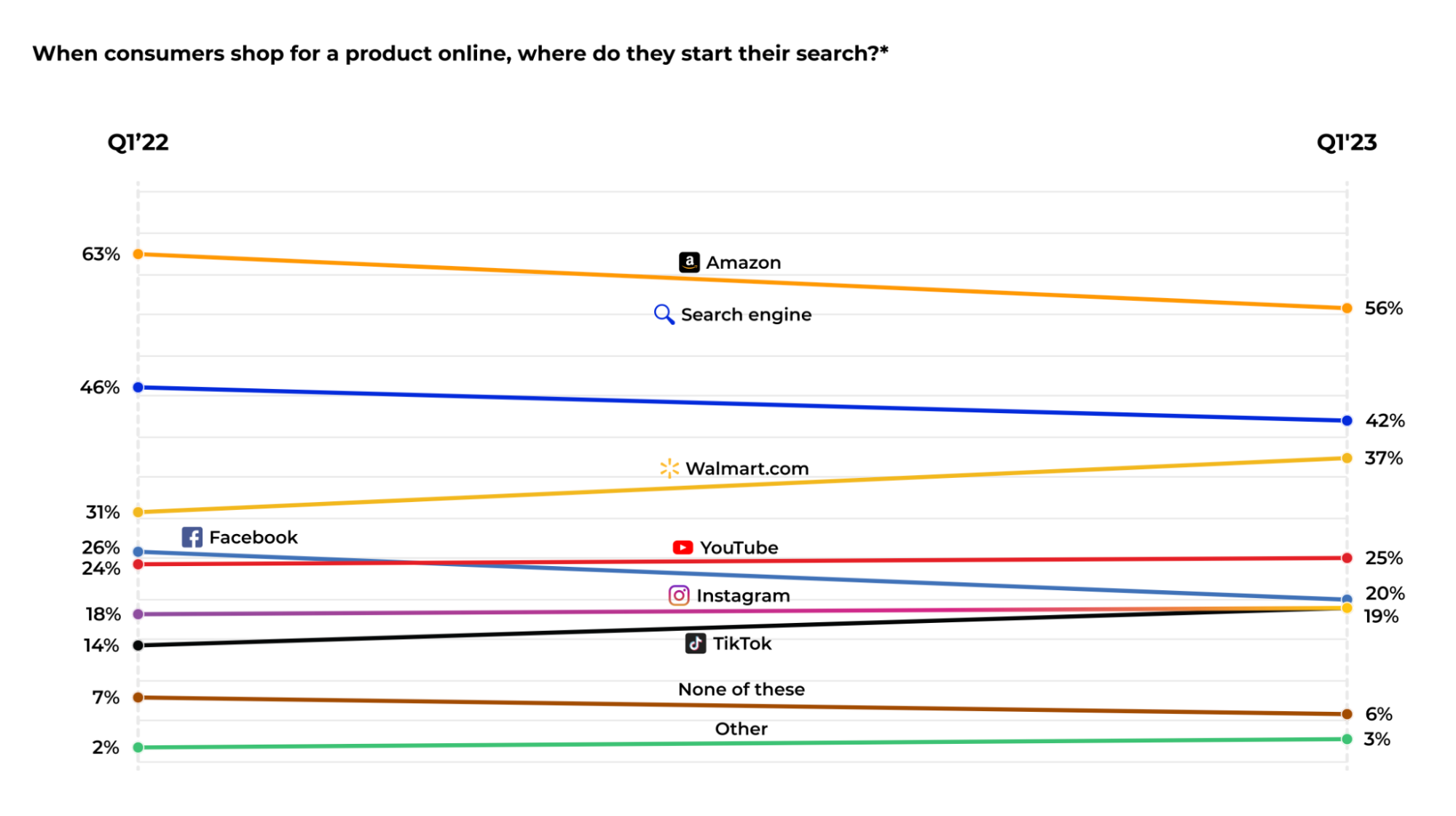
Source: Jungle Scout Q1 2023 Consumer Trends Report
Therefore, if you understand Amazon SEO, then your products’ visibility and ranking improves, which drives more sales!
A9: The foundation of Amazon SEO
Amazon’s search algorithm comes from a former subsidiary company called A9, and is the brains behind matching a customer search query with the most relevant products in the Amazon catalog.
This algorithm is crucial to Amazon’s business model because it powers the one primary metric that matters the most: revenue per click. And by honing in on the products most relevant to a customer’s search query, Amazon increases its chances of generating a sale — and revenue.
We get a sense of what the A9 algorithm targets in Amazon’s article on Optimizing Listings for Search and Browse:
“Factors such as degree of text match, price, availability, selection, and sales history help determine where your product appears in a customer’s search results. By providing relevant and complete information for your product, you can increase your product’s visibility and sales.”
Amazon’s search algorithm comes from a former subsidiary company called A9, and is the brains behind matching a customer search query with the most relevant products in the Amazon catalog.
This algorithm is crucial to Amazon’s business model because it powers the one primary metric that matters the most: revenue per click. And by honing in on the products most relevant to a customer’s search query, Amazon increases its chances of generating a sale — and revenue.
We get a sense of what the A9 algorithm targets in Amazon’s article on Optimizing Listings for Search and Browse:
“Factors such as degree of text match, price, availability, selection, and sales history help determine where your product appears in a customer’s search results. By providing relevant and complete information for your product, you can increase your product’s visibility and sales.”
We’ll show you how to provide the information Amazon’s A9 algorithm is looking for.
Back to Top
While Amazon keeps a tight lid on the details of its A9 Search Algorithm, there are a few key factors that we know help to determine a product’s rank.
For example, when you create an Amazon product listing, you are telling Amazon: “Hey, this is what my product is.”
Then, when customers click on your product listing and make a purchase, they, too, are telling Amazon: “Yes, this product is exactly as described and precisely what I was looking for.”
Think of Amazon’s A9 search engine as the smartest person you’ve ever met. However, this person lacks confidence in their answers. It’s not until a few thousand people tell the person they’re right that they start to believe it themselves.
And that’s Amazon SEO and the A9 algorithm in a nutshell.
If Amazon’s A9 search algorithm doesn’t know what your product is, how can it make sales? And how does Amazon even know what your product is in the first place?
The answer is surprisingly simple: relevant keywords.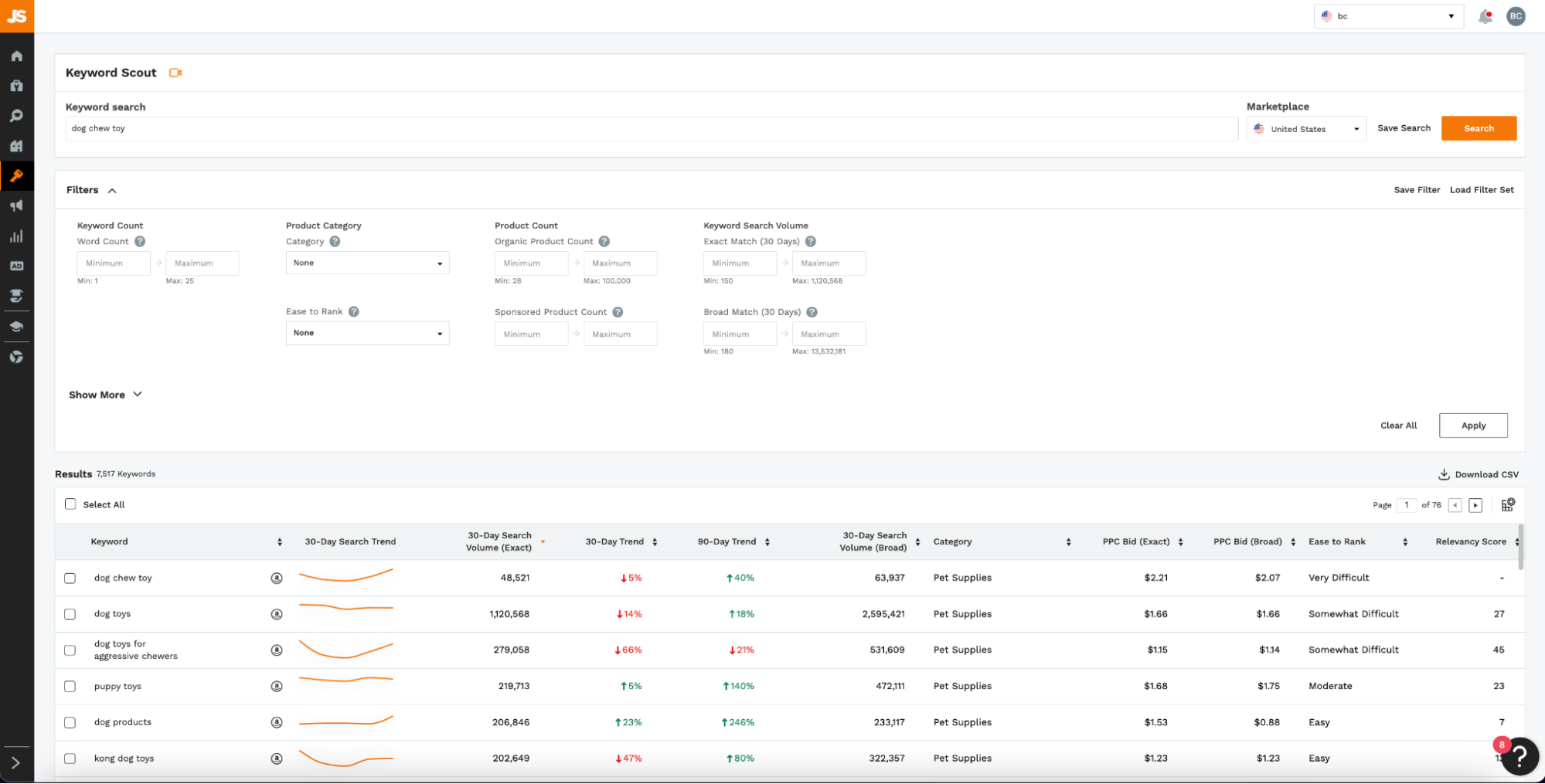
When you create your Amazon FBA product listing, Amazon requires a lot of information including:
All of these elements are used by Amazon’s algorithm to understand what your product is (more on creating an optimized listing below).
READ MORE | Here’s our complete guide on how to optimize your product listings on Amazon.
Since Amazon is a business (and businesses want to make money), the more money your product brings into Amazon, the more likely your product will rank.
A product’s sales velocity represents how much money it’s bringing in over time. It’s a measure of the number of opportunities (in this case, page impressions) multiplied by the average sale, multiplied by the conversion rate, all divided by the sales length cycle.
Here’s an example to help clarify how sales velocity is calculated:
(3000 x 20) 0.10 / 30 = 200
That means your sales velocity is $200 per day.
Conversion rate
Conversion rate is the percentage of visits to your product page that result in a sale. It is calculated as follows:
Conversion rate = Total order items / Sessions
In Seller Central, you can see the conversion rate of your product by going to Reports –> Business Reports –> Detail Page Sales and Traffic, and then looking at the Unit Session Percentages. This is what it looks like for our Jungle Creations products
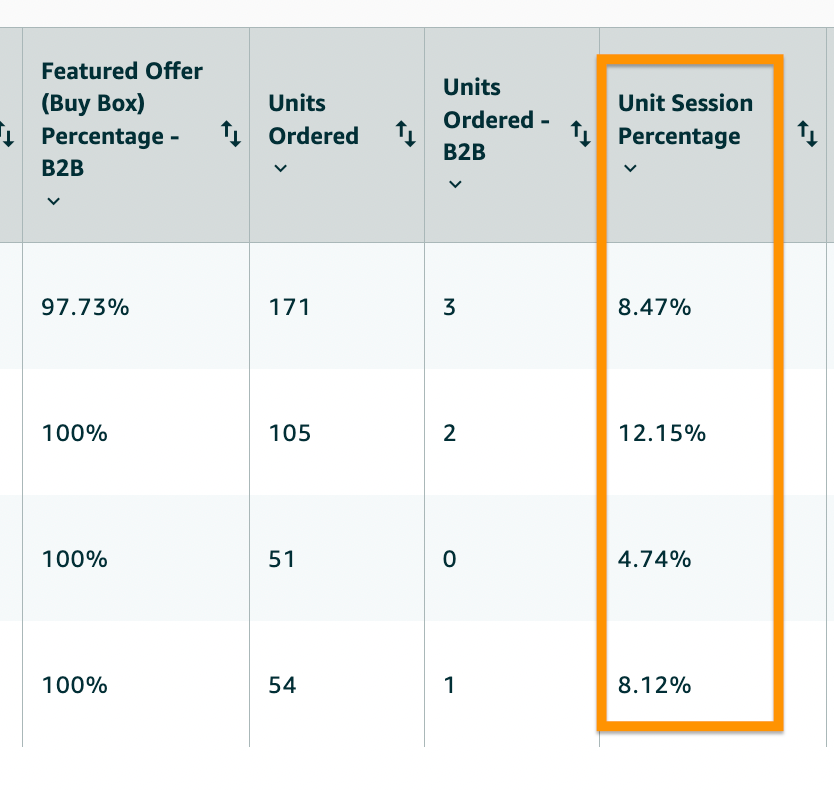
The three most important factors to improving your conversion rate are:
- High quality product images
- Competitive price
- Social proof (number, quality, and rating of reviews)
As you make adjustments to different parts of your listings, you can see the changes reflected in these metrics.
For example, if you start testing a different main product image, you may see an uptick in your click through rate and sessions. Or, if you change the main keyword you’re targeting, you may eventually see a dip in sessions. But, as you are targeting more relevant traffic, you could also see a lift in sales.
Your conversion rate is going to be dynamic, changing based on changes in traffic, customer behavior, and market conditions in general. It is tremendously helpful to stay attuned to these changes, and proactively make necessary adjustments. This means consistently running split tests to optimize the keywords you target, the images you use, your price, and much more.
Conversion rate is the percentage of visits to your product page that result in a sale. It is calculated as follows:
Conversion rate = Total order items / Sessions
In Seller Central, you can see the conversion rate of your product by going to Reports –> Business Reports –> Detail Page Sales and Traffic, and then looking at the Unit Session Percentages. This is what it looks like for our Jungle Creations products
The three most important factors to improving your conversion rate are:
As you make adjustments to different parts of your listings, you can see the changes reflected in these metrics.
For example, if you start testing a different main product image, you may see an uptick in your click through rate and sessions. Or, if you change the main keyword you’re targeting, you may eventually see a dip in sessions. But, as you are targeting more relevant traffic, you could also see a lift in sales.
Your conversion rate is going to be dynamic, changing based on changes in traffic, customer behavior, and market conditions in general. It is tremendously helpful to stay attuned to these changes, and proactively make necessary adjustments. This means consistently running split tests to optimize the keywords you target, the images you use, your price, and much more.
Back to Top
As we’ve discussed, the primary ingredient to rank highly with Amazon SEO is relevancy, and every element on an Amazon product listing helps with relevancy.
But, before we go into the individual components of your Amazon product listing, it’s vital that you understand the actual structure of the listing itself.
Amazon’s user experience designers placed each element of a product listing in a specific position, based on common internet-user reading habits (most internet users — you and I included — read in an F-shaped-pattern).
First, the user starts at the top-left corner of the screen, scanning the content. On Amazon search results pages and product listings, the first things the user sees are the product photos.
Next, it’s the product’s title (with the price very close to the top). And at the far right of the listing, still in line with the other content, is the Buy Box.
If the user does not make an immediate purchase based on the image, title, and price, they scroll further down the page and make a second horizontal movement. That means the user sees the items’ delivery options, product variants, and bullet points.
The final movement involves the pattern’s vertical movement.
As a user scrolls past ‘the fold’ on an Amazon page (the portion of the page a user sees when they first log on), they are treated to more content to convince them to make a sale. This includes competitor products, offers and promotions, a detailed product description, questions and answers, and reviews.
With this knowledge of a user’s reading pattern, we can order the product listing’s elements from most important to least important.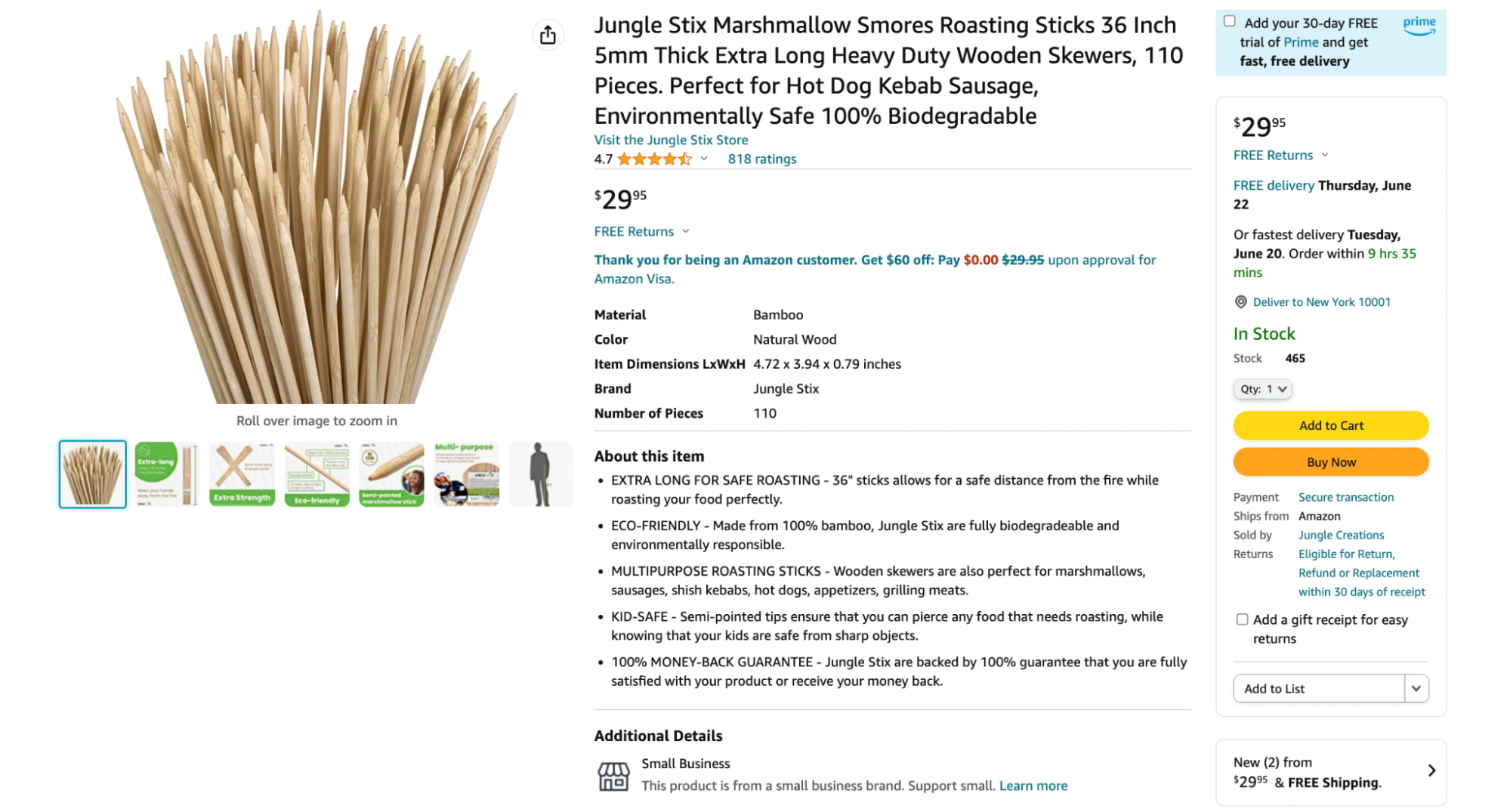
When it comes to the components of a product listing, those that are ‘above the fold’ can be seen by a potential buyer when they first click through to your page, without scrolling down.
They include: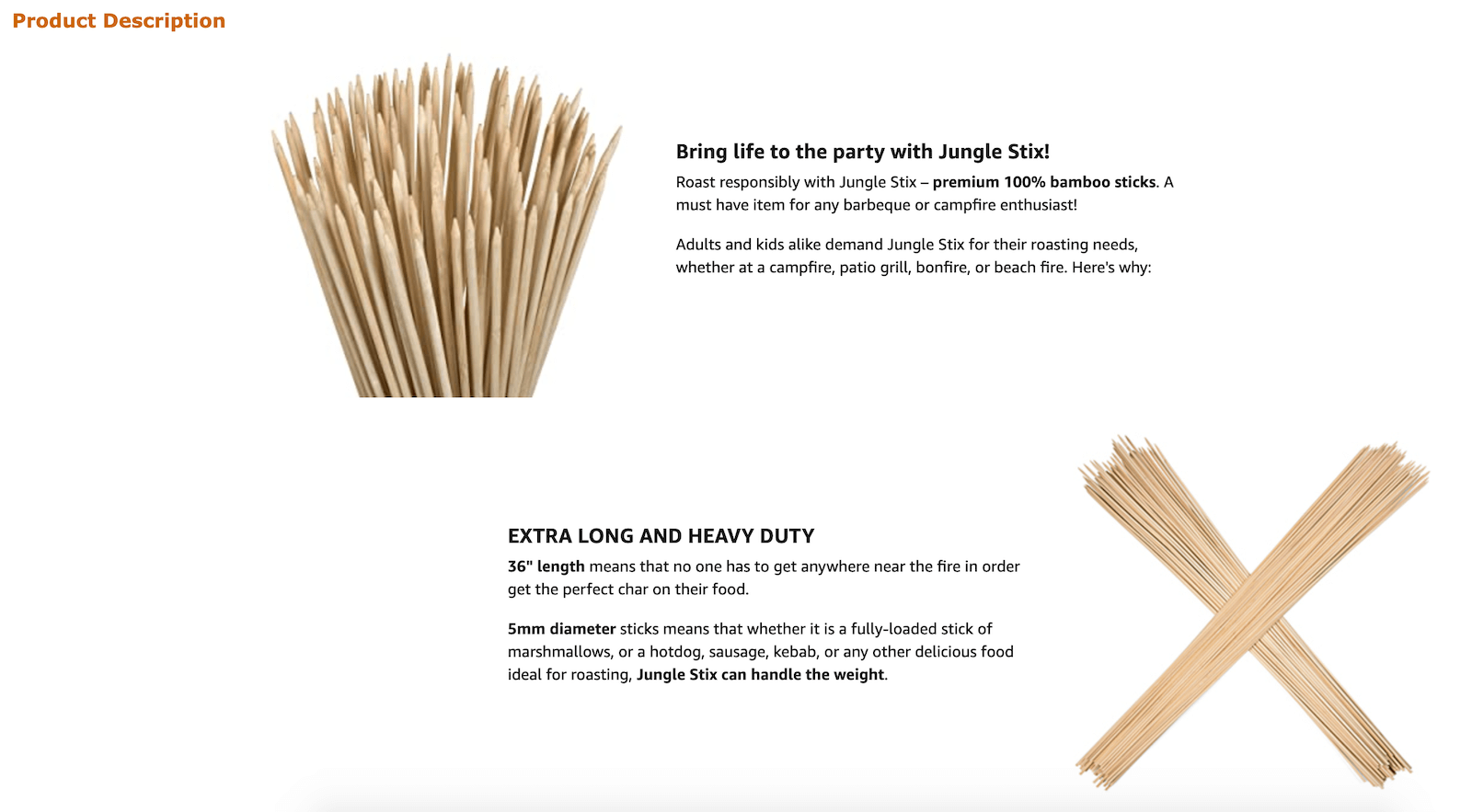
As for components ‘below the fold’, those are the listing’s elements that a shopper can only view if they scroll down the product page.
These include:
Back to Top
Now that you’re armed with a basic understanding of Amazon SEO and user experience, you should be able to optimize your Amazon product listing for relevancy and conversions (sales velocity).
Your product’s image is everything. It is the first impression the customer receives of your product, so make it a good one. The main image should be clear, needing nothing more than a quick glance from the customer in order for them to know exactly what the product is.
Until Amazon has sales data to back up your product’s claims, the title is crucial for proper Amazon SEO. So, the next thing you need to do is construct your product title so it conveys the most important information first, from left to right.
If you need some help creating your title, Amazon constructs its own product titles using the following formula:
[Brand] [Product Type] [A Defining Characteristic] [Specific Use] [Size and/or Quantity]
For example, Brita Filters are listed as Brita Standard Water Filter, Standard Replacement Filters for Pitchers and Dispensers, BPA Free – 6 Count.
Good product ratings can make or break a product. After all, your product can be the most relevant product in the world, but if it has three stars or less it may not sell. To avoid that from happening, make sure that: a) your product is exactly what you advertise on your product listing, and b) you follow-up with your Amazon customers to address potential issues.
Obviously, pricing is an important factor when someone considers making a purchase on Amazon. And while you don’t want to give your product away for next to nothing, you also don’t want to scare off buyers with over-inflated prices. Look at what your competitors’ are doing, and price test often to secure the best possible pricing for both you and your shopper.
Most of us want what we want when we want it. In other words, we want fast shipping! That’s why Amazon has over 200 million Prime members: two to three-day shipping (one-day or same-day for some). Naturally, because of this desire to receive their purchases as quickly as possible, products with the Prime badge sell better than those without.
If you are an Amazon FBA seller and use Amazon’s fulfillment network, your product automatically qualifies as Prime. If you’re not selling FBA, you can always apply to be a part of Amazon’s Seller Fulfilled Prime program.
Even if you’re the only seller on a product listing, you can still lose the Buy Box. And without the Buy Box, some shoppers may decide to move onto one of your competitor’s listing to buy from them instead. To make sure you’re eligible for your own Buy Box, always follow Amazon’s rules carefully.
If you happen to lose the Buy Box (either because of ‘hijackers‘ or Amazon deems you no longer eligible), it is possible to win it back. Check out our blog, How to win the Buy Box, to find out how.
The last thing you want is to lose a sale because your product comes in red and the buyer wanted black. Variants help with conversions, so failure to offer variations (if your product is variation-friendly) could mean losing a customer to one of your competitors. So if you can offer variants, do so, and do so on the original product listing; creating a separate listing for variants isn’t always beneficial.
While the jury is still out on whether or not products suffer when they run out of stock, the bottom line is that you can’t make sales if you don’t have any units to sell. In the meantime, as you wait for your next shipment of inventory, your competitors are signaling to Amazon that their products are more relevant than yours.
Regardless of the debate, our recommendation is to remain in stock!
It’s a mistake to use your bullet points for keyword stuffing. Instead, use bullet points to help your product convert. Offer information that the images and title could not convey. A great tip is to answer the question: how does my product solve the problem that led this customer to my product in the first place.
Learn from your successful competitors’ product listings. Click on their listing and do a little research. What makes their product more relevant than your own? What makes their listing more effective than yours? And check their sales, too. Is their product actually doing better than yours?
Consider this: a shopper moves past the fold of your listing because they weren’t convinced to buy right away. But they also weren’t interested in the sponsored products, or the ‘Customers who bought this item, also bought…’ section. Therefore, it’s possible you can change their mind with something as simple as a 10% discount. Plus, you can offer a promotion without advertising it.
This is your chance to showcase the benefits and talk up the product’s advantages, so make sure the product’s description drives home why the customer should buy your product over everyone else’s. And, if you’re a brand-registered seller, here is where you can create A+ content.
If you have a registered brand on Amazon, you will have access to A+ content. Not only does A+ content give your page a sharp, professional look, but it may also improve your commissions. We ran an A/B test with A+ content on Jungle Stix and discovered that it improved our conversion rate by 150%.
This is probably one of the most difficult parts of being an Amazon seller. One bad review can tank your entire listing.
But I believe that you can still get good product reviews. You just have to do it the old fashioned way: by making a great product that people want, offering amazing customer service, and using Jungle Scout’s Review Automation tool.
Once you have a well-optimized listing, it’s time to spike your sales, as nothing will boost your ranking like cold hard sales can.
Two of the best ways to increase sales are:
Paid advertisements are a great source of traffic and additional sales to help rank your products. Facebook or Google Adwords can be used, but Amazon PPC is the easiest way to boost your keyword driven sales.
Start by setting up manual PPC campaigns using your target keywords, then crank up the bids (but staying within your budget) to increase exposure and sessions.
Social media is a very powerful way to grow your brand and generate interest in your products.
Many sellers in today’s world take advantage of TikTok and influencer maketing to promote their products in such a way that doesn’t feel like an advertisement.
Back to Top
What good is optimizing your listing, working on Amazon SEO, and boosting ranking if you can’t track the results? There are two ways to check if your product has been indexed and where it is ranking for keywords: manually and automatically.
First, check your product is indexed for keywords by typing the following formula directly into the Amazon search bar:
(ASIN) + “(keyword)”
Populate the brackets with your product ASIN and a keyword you wish to check. If your product shows up, it’s indexed for that term.
Then when it comes to tracking ranking, you’ll need to manually scroll through pages to find it. Checking this every day certainly gets old quickly!
Because checking your rankings manually can be extremely time consuming, your best bet is to find a tool that enables you to monitor your Amazon product listings automatically.
By using a tool like Jungle Scout’s Rank Tracker, you can track your product’s ranking, as well as those of your competitors. It also helps you find new opportunities while eliminating inefficient keywords.
Back to Top
And that’s it! Hopefully this article has given you a solid start on mastering Amazon SEO, however, if you’d like to learn more, be sure to check out the Jungle Scout YouTube channel:
Back to Top
If you have any tricks you use for Amazon SEO you’d like to share, feel free to drop them in the comments below.
Amazon Best Sellers Rank (BSR) Meaning: Everything You Need to Know in 2024
Brian Connolly
Brian is a writer and entrepreneur with over 6 years of experience in e-commerce and selling on Amazon.
local_offer Tags: clothing product trends, ecommerce, Seller Stories, Selling on Walmart
This Amazon SEO guide is a goldmine! From optimizing product listings to leveraging keywords, it’s a comprehensive resource. As an e-commerce seller, I found the step-by-step approach and real-life examples incredibly helpful. A game-changer for boosting sales on the platform!
Hi Brian, very good posts on how to optimize a product on Amazon. Based on our experience, it is also super important for SEO on Amazon to be able to offer discounts and price reductions, as well as helping to improve the CTR (Click-Through-Rate).
We hope that our contribution will serve the readers, thank you very much for the post and best regards!
if we list our product on amazon, in how many days it will rank on top? is there any backlink system in amazon SEO?
Hi James,
There is no one simple answer for that. Your product will not rank on top in a matter of days if it is brand new. You must focus on getting sales. You can get sales organically when first launching a product but your best bet would be through your own promotions and Amazon PPC advertising. If your listing converts well, Amazon will begin to rank your product for keywords they believe are relevant to your product.
nice information about seo. People sholud understand that there are much difference in seo’s pattern
Your articles are really very useful, Keep updating to always provide insight to everyone, I will always read and share your articles, thank you!
Thanks for the support and for reading!
Wonderful guide buddy! I will definitely try this techniques.
Thanks for reading!
Thanks for sharing this post with us…Great work.
Hi Jungle Scout,
I am a freelancer in Digital Marketing in Bangalore. I have read your article. You really did very good research.
Thank you for reading!
Thanks for posting this information, it is very helpful for all of us. Keep update with your blog.
nice post
It help me a lot. Before this i don’t know the sales velocity, how to check indexing, ranking tracking, dont use punctuation in keywords….
Thanks
very nice blog! thanks for sharing this.
The information you give in the blog is very nice!
Thanks for reading!
I read your blog. The information you give in the blog is very good.
Thanks for reading!
Hi,
This is a good post regards Amazon SEO guidance to improve Product Rankings on Amazon. I learn a lot of from this blog and appreciate your work.
Thanks.
Thanks for reading!
nice blog keep it up and insert some more blog . thanks for sharing with us
amazing piece of content , really helped us out with a few of our listings. Followed keep it up
A pool of knowledge
Hi Gen,
It was very useful. Thank you for sharing this information and help us.
Hi JungleScout Team, yeah this post is really fastidious and I have
learned lot of things from it
thanks for the information.
Hi Gen,
Could you please clarify regarding keywords used in Product Title, Bullet Points, Product Description, Product Image vs Search Term’s keywords in Seller Central? Sould I or should I not repeat these in Search Terms again? Wonder if that would be considered keywords stuffing?
Thanks,
Natasha
Natasha,
Amazon wants your products to be relevant to buyers. Unlike Google, they don’t penalize for keyword stuffing. So if you’re arming your listing with more long tail options that’ll help you get in front of more customers who actually want to buy your exact product, they’re only going to reward you. High conversions means your customers aren’t having to spend a lot of time making decisions–they see what they want and buy it. That signals Amazon that your product is worthy.
[…] Read the full Amazon search optimization guide at Jungle Scout. […]
Thanks for sharing this excellent post with us.Keep doing good work.
Excellent piece of content Gen, really helped us out with a few of our listings. Followed!
Hi Lila,
Thanks for letting me know, glad that it helped!
Gen
Amazon SEO & Product Content Series. As most Amazon sellers already know, optimizing product content is an intentional strategy that can have a direct impact on their product(s) organic search ranking. … The Amazon search algorithm is somewhat of a black box still https://www.peopleperhour.com/hourlie/do-500-wishlist-for-amazon-product-ranking/368408?ref=member
Another Great Post! Yes keyword research is very necessary element to create a post. We should use meta in a proper way at the post.
I just want to ask that interlinking with my old post is good for SEO. And How many keywords should actually add in meta keywords.
How to i get top seller rank #1 ?
SEO Challenge:
Which is work fast?
1. Tools
vs
2. Human
That’s a great question, and a challenge that many are pursuing….please share any good tips you come across in your quest!
Thanks for sharing this post. The tips are very helpful.
Hi Sandra, of course, glad that you are finding value in the posts!
nice your website inform,, i like that,,Before you put your product listing on Amazon, you should spend some time finding the most appropriate keywords to target. There are several factors that Amazon applies to establish the organic search results. It incorporates product cost, sales history, volume of sales, ratings, reviews, etc.
Hi Helen,
Thank you for sharing your thoughts, you have indeed highlighted some of the most important ranking factors.
Gen
someone told me, jungle scout tools are excellent for Amazon Seo. But I am confused about tools.
Is it work properly!
Is it improve seller rank! and
Is it safe for seller account!
Now, I am using organic System like prime Customer ( Listing, vote, Shopping list, gift idea, review, Purchase, Social sharing ) etc.
It works slowly but Safe.
Email me : [email protected]
Yes, Jungle Scout is the first, and most robust, product research tool on the market!
Really nice post. thanks for sharing with us.
keep continue your good work.
Hey Shagalov, glad that you got value out of the post!
Good article, but I think your CTR calculation is wrong. Please correct me if I’m wrong, but Page Views is the total number of times that your listing is actually clicked on and visited. Sessions is the number of unique times your listing is clicked on and visited.
So by dividing these you are not calculating the number of people that clicked on your listing vs the number of people who saw the listing, which is how CTR should be calculated. Instead, you are just dividing the number of unique visits by the number of total visits, which to me tells you nothing about CTR.
Hey Jeffrey,
Good spot, I have updated the article now. I was just investigating in Seller Central, and I don’t think Amazon actually give you impression data for your product listing, (apart from in any PPC reports). Organic impressions of your listing would be really interesting to see though, have you managed to access this data?
Thanks again,
Kym
Unfortunately, I believe you are correct. There does not seem to be any way to see the number of times your listing was viewed. It seems that the only info they provide is the number of times your listing was actually visited.
Yes it seems Amazon keeps this information to themselves. After all they “own” all of the listings technically.
It does make a case for using Amazon PPC, to get more data about your page views and keywords – again this works in Amazon’s favor, but it’s no different to the way Google operates with their Analytics and PPC platforms!
Hey guys, great article! I think that looking into the A9 algorithm is extremely important when trying to acquire a deeper knowledge of Amazon. It is important to learn as much as you can as an Amazon seller so you can be ahead of the rest of the pack. Furthermore, like Google, Amazon is constantly tweaking its algorithm so it is good to always be informed! I hope you benefit from my input!
Please feel free to reach out to me with any question!
Thanks,
Weston Corica
Lead Consultant
Thx for the great post.
1: So if you use your main keyword in the title there is (rankingwise) no need to repeat this term anywhere else?
2: If you want to rank for longtail phrases like ‘best bamboo marsmallow’ would it be helpfull to put them next to each other of can they be anywhere in the listing?
Hi,
you are saying that you can enter your own picked key words to product image names. Could you tell us more about that? Because as far as I understand, Amazon doesn’t allow to do this. At least in these rules:
https://www.amazon.com/gp/help/customer/display.html?ie=UTF8&nodeId=201995020
Maybe these rules are outdated? What is the best practice in real life?
Thank you in advance!
Thank you for sharing this very informative, useful and well written article. Helped me a lot. Keep it up! 🙂
Great Post Gen! I have a couple of questions. Isn’t ‘Unit Session Percentage’ an accurate assessment of conversion rate as well? The formula is units ordered/sessions so I figure it’s a great metrics to use as conversion rate. I use that for myself and my clients to make listing decisions. Also, how do you define ‘significant search volume’ when selecting a head term?
I’m going to start using revenue per click and organic CTR for my reporting. Awesome tips.
Thanks again brother. Tell Greg I said ‘hey’…it’s been a while.
Hey Sean,
Thanks for the kind words, glad that the post helped.
Indeed you are correct, Unit Session Percentage is the same conversion rate.
As for what is the minimum threshold for “significant search volume”, it totally depends on your goals as a seller. However, you can do some quick back-of-the-envelope math to justify whether a keyword is worth prioritizing for you. if you have some historical sales data and/or PPC data, you can multiply the Total Impressions x Click Through Rate X Conversion Rate = Sales
in that way, you can run the numbers for various keywords and see which ones ultimately are most likely to generate more conversions. hope that makes sense!
Thanks Sean.
Gen
Hello Gen,
Thank you for always writing such detailed post, it’s very useful to me as a beginner Amazon Seller.
1) Regarding keyword (seller central tool) section, in your example say “marshmallow for roasting”, “marshmallow stick for roasting”, “marshmallow roasting forks” and “marshmallow forks” since Amazon does not recommend us to use repetitive keywords, I would like to clarify if its enough to input the following keywords: marshmallow stick fork roasting?
The reason I am asking is because based of Google keyword planner when I put in a product type or website, it generates a list of phrases with repetitive words and honestly I find it difficult to max up the character limit in search term.
2) Under Amazon Seller Central > Report > I do not see option for Business Report?
Could you please out thank you so much!!
Hey Sy,
Glad that it helped. To answer your questions…
1) Per Amazon’s recommendation, it would be sufficient to take those four phrases that you listed and condense them into “marshmallow stick fork roasting” in Seller Central’s backend Keyword section.
2) You can see the Business Report in this screenshot: http://screencast.com/t/oOGG86egcCM
Hope this helps!
Gen
Everything is very open with a precise explanation of the issues.
It was truly informative. Your site is extremely helpful.
Thank you for sharing!
I just changed with seller support and they told me:
“As I have checked the information, As per Amazon policy, it is not allowed to promote your product via description.”
Good to know, thanks for following up!
The pet groom example you gave with the description which was nicely formatted and descriptive has the following in their description:
“Buy 3 Safe 15%…”
Is this allowed>
Hey Dan,
Good catch, technically it isn’t allowed per Amazon’s policy, see here: http://screencast.com/t/OwTRt6dp
Hi Gen The best post I have read.
In my case have mi short title (80 caracters aprox.) for recomendation in help of Amazon Seller Central.
I think wasting space could place keywords but:
It is wrong to follow the recommendations of Amazon strictly?
In my case following strictly, but I have no positive results so far.
You think about it?
Best regads
Hi Janeth,
Thanks for the kind words, glad that it helped!
I absolutely don’t think that there is anything wrong with following Amazon’s recommendation, and it is probably advised. I know that a lot of sellers may skirt around the policies (ie html formatting in the product description, or graphics on main feature image). However, with the Main Product Name you should be allowed more characters, depending on your category, so it may be worthwhile to add more keywords and see if that increases your daily sessions, meaning that you are appearing for more keywords.
Would love to hear if that helps!
Your email address will not be published.
Need help?
Visit our Help Center
Products
Solutions
Features
Resources
Support and Community
Company
Copyright 2024. All Rights Reserved




